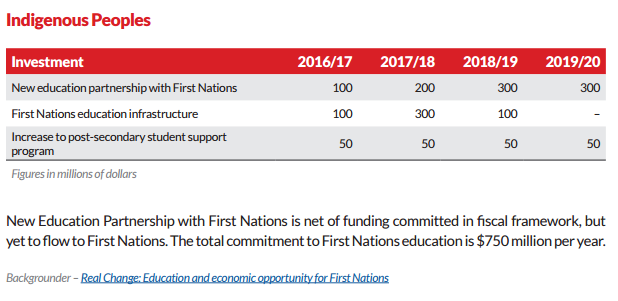First Nations Education is critical social infrastructure
Many Canadians know that the federal government is responsible for funding social services, health care, education and income supports on First Nations reserves.
Few people realize that the escalator for these transfer payments has been frozen at 2% per year since 1996, without consideration for population growth or need.
According to the Assembly of First Nations, by 2011 this resulted in an average funding gap of $3,500 per student in First Nation schools compared to per student funding in provincial schools.
This operational funding gap is on top of a physical infrastructure funding gap for resources such as libraries, computer labs, or supports for First Nations languages.
This is particularly egregious given low high school completion rates, high risk of suicide, and the fact that half — 50% — of First Nations children live below the poverty line.
This should be a collective shame for Canadians and a key election issue.
Conservative Track Record
In 2014, the Conservative government made a commitment to First Nations education that consisted of $1.25 billion in core education funding over three years, $500 million in infrastructure funding over seven years, and $160 million to implement the plan. (See Budget 2014, pg. 76).
This money was contingent on the passage of the controversial First Nations Education Act (Bill C-33). Â A centralization of control in the hands of the Minister of AADNC concerned many First Nations communities, the bill was withdrawn, and the money promised for elementary and secondary education was never spent.
Budget 2015 made more modest promises, committing $200 million over 5 years to “improve educational outcomes”, and keeping the $500 million in infrastructure funding over seven years. (See Budget 2015, pg. 294)
The commitment of $1.25 billion in core education funding for First Nations communities vanished in Budget 2015, and in fact had never made its way into Department planning documents because the bill (C-33) never passed the House. (Budget 2014 had earmarked the money to start in FY 2016-17).
Election 2015 Promises
The New Democrats have yet to fully detail their platform on First Nations education, but the Liberals have promised $2.6B over the next four years for education funding.
It turns out that only 900 million of this is new funding, the rest depending on Budget 2014’s commitment of $1.25B that appears to have evaporated from Budget 2015’s fiscal framework.
Budget 2015 only shows an annual investment of $40 million for First Nations Elementary and Secondary Education ($200 million over 5 years).
If it turns out that money *is* sitting around on someone’s desk at the Treasury Board, that would be great, because this funding is sorely needed to close the education funding gap for First Nations communities. But Parliamentary appropriations documents, including the department’s Report on Plans and Priorities and Treasury Board’s Main Estimates, suggest that this is not the case.
Rebuilding Social Infrastructure
Our current debt in social infrastructure has been ignored for too long. The Federation of Canadian Municipalities has put out good numbers on the current municipal infrastructure debt, but no one has done something similar for social infrastructure.
Along with investments in early childhood education and care, repairing the funding gap to First Nations schools would go a long way to eliminating that social debt for future generations. Ask your local candidate for their party’s position, and after the election, keep pushing. It’s too important to ignore.



The NDP has come out with their Indigenous platform today, and APTN has a good comparison of the three major platforms on education: http://aptn.ca/news/2015/10/07/ndp-promise-on-core-first-nation-education-richest-among-three-main-federal-parties/